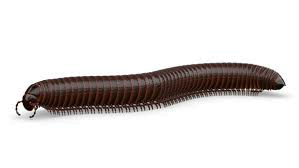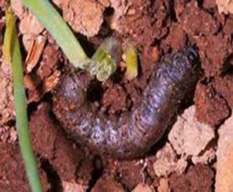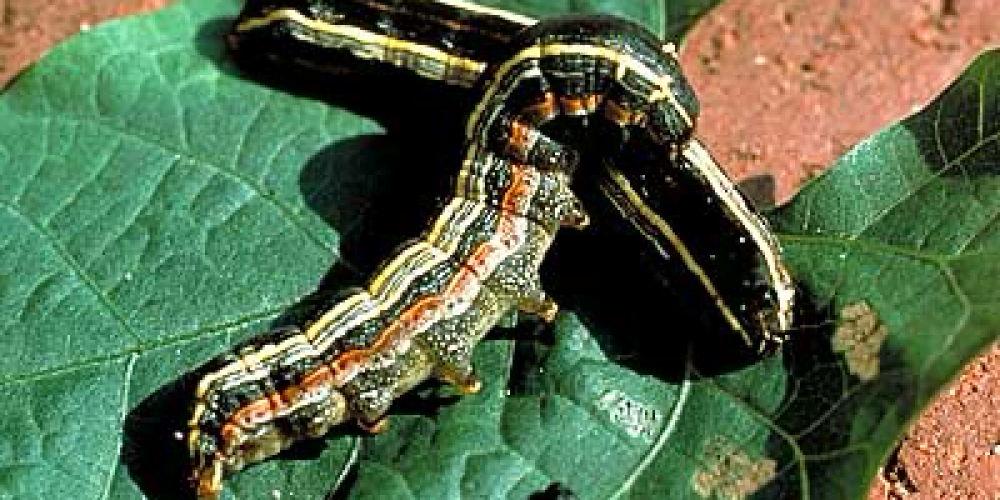Table of contents of the article
ToggleCutworm attacks a wide range of crops, causing significant damage. In this article on your website, World of Plants, we discuss how to prevent them.
Introduction
الإسم العلمي : Agrotishg ipsilon
The larvae burrow into the stems of plants in the ground, causing the plants to fall onto the surface of the soil in an area between the soil. When digging next to the plants, you will see the larvae being arched and gray in color.
Cutworms are considered one of the important pests that cause significant losses to seedlings. When the infestation becomes severe, the farmer is forced to replant again, which leads to delayed plant growth and the plant not receiving its full thermal needs, which leads to a decrease in yield.
The reason why the larvae of this insect are called cutworms is that in their final stages of growth, these larvae are unable to climb plants due to their false abdominal legs being devoid of hooks. Therefore, these larvae are content to crawl only on the surface of the soil and feed on the stems of the young plants they encounter, and often The loan is complete.
Symptoms and damage of cutworm insect
One caterpillar can attack and damage more than one plant. So Cutworm infestation is characterized by the fact that it appears suddenly and in scattered spots in the field. The reason for its sudden appearance is due to the presence of larvae (the harmful stage) under the surface of the soil and their emergence at night.
One of the symptoms of infection is the presence of seedling stems tilted above the surface of the soil as a result of the larvae gnawing on the seedlings, whether completely or partially, directly above the surface of the soil, as well as the presence of some leaf fragments next to the gnawed seedlings as a result of the larvae gnawing on leaves near the surface of the soil. It is possible to find larvae under the gnawed plants or Close to it, and you rarely find more than one larvae under the plant because of the phenomenon of predation among them. It is preferable to discover the infestation when the larvae are in their early ages.
Comments about cutworm insect
The insect infects plants in the nursery...as well as in permanent soil. As a result of the larvae feeding on the plant stems, you will see the plants with their stems separated from their roots, which leads to wilting and then death.
Cutworm host plants
There is a wide range of host plants such as potatoes, tomatoes, peppers, eggplant, corn, cotton, rice, alfalfa and cereals.
The life cycle of the cutworm insect
A multi-family insect, its activity increases during the fall, winter and spring seasons and decreases in the summer. Butterflies are active at night and females lay eggs individually or in small groups on cultivated plants and adjacent grasses, preferring blackberry weeds..
There are several types of cutworms, the most important of which is the black cutworm. This insect has about six generations per year, the most dangerous of which is the third or fourth generation, which corresponds to the emergence of seedlings at the end of March and early April. The generation period lasts from 32-40 days depending on environmental conditions and during the summer in In mid-June, it almost disappears, and research indicates that it migrates to cold areas.

The adult insect emerges from the pupae in the soil, where the females lay eggs individually or in groups of 30-50 eggs each on the lower surface of the leaf or on the stem. The female lays about 700 eggs on average within 7-15 days, where the eggs hatch after an incubation period of 7-15 days. It turns into larvae, and the duration of the larval stage is one to two months, depending on the temperature and relative humidity. Then the larvae pupate in clay cocoons at a depth of 3-5 cm in the bed, and the butterflies emerge after 2-6 weeks, and the age of the butterfly reaches 2-3 weeks.
The harmful stage is the larvae, which feeds on the leaves of the host plant for two weeks. After that, it descends to the soil and remains there during the day within 10-25 mm of the soil surface, while the large larvae feed by biting the stems of plants at the soil surface level. Then the plants begin to yellow and wilt and then die.
Prevention and treatment of cutworm insect
1- Agricultural and mechanical methods:
- Care should be taken to prepare the land for planting by plowing the land deeply to expose the larvae and pupae to the sun and natural enemies, especially after clover.
- Early in servicing the land and taking care to remove weeds, as they attract butterflies to lay eggs and also harbor young caterpillars, as well as weeds on the waterways, and carrying out the hoeing process at frequent intervals.
- Do not plant cotton directly after clover. Rather, the land must be plowed well after mowing the clover and left exposed to the sun for a long period, with repeated plowing, solarization, and ventilation, because drought and heat kill many of the larvae and pupae, and birds also devour many of them during plowing.
- Remove weeds and plant remains that provide a good environment for laying eggs.
- Collect the larvae in the morning or before sunset, where the larvae are present on the surface of the soil, and destroy them. This method is not practical in large areas.
- Kerosene can be added to irrigation water at the rate of one plate per acre. This is done by piercing the plate, and the kerosene falls from it regularly and slowly, carrying the water to the field. This kills the larvae, and the smell of kerosene drives away butterflies before they lay eggs.
- Using light or pheromone traps to attract butterflies.
2. Chemical control of cutworm
Use of poisonous baits: In the case of severe infestation, poisonous bait is used as a tamper around the plants. The ground is irrigated in the morning, then the poisonous bait is placed as a slurry between the lines at sunset. Cutworm infested areas are identified when they appear in two sockets before thinning or one socket after thinning. They are placed Poisonous bait is next to the enemy in order to protect the enemies. The bait is used as a trap, as it is used:
Soft powder at a rate of 20-25 kg, treacle and 1.5 kg of yeast, then add 300 cm3 of 48% bariban pesticide or 2.5% rock pesticide.
The toxic bait consisting of Hostathione 40% EC at a rate of 1.25 liters or Marshall 25% WP at a rate of 1 kg can be used with 15 kg of fine powder, adding an appropriate amount of water until a paste can be made, and the toxic bait is compressed around the affected plants before sunset.
The pesticide Chlorzan 48% E.C is used as a poisonous bait and is prepared as follows: 15 kg of corn grits or local sorghum + 20 liters of water + 1 liter of pesticide, then the ground is irrigated in the morning, then the poisonous bait is placed as a sediment between the lines at sunset. Chlorphan 48% or Sidon 40% can be used to prepare poisonous baits.
Among the new pesticides that are used to combat borers and cutworms are Terragard 48% pesticide at a rate of 1.25 liters/acre, Challenger at a rate of 50 cm3/liter of water, Numolt at a rate of 50 cm3/liter of water, or Neodrin at a rate of 300 cm3/acre, in the same way as the previous toxic bait.
– Direct spraying in the direction of the market bases with one of the recommended pesticides, such as Lanit 90% SP at a rate of 75 grams/100 liters of water or Raildan 50% EC at a rate of 250 cm3/100 liters of water.
3. Biological control of cutworm
Predators: Many types of spiders, ground beetles, and cockroaches prey on the caterpillars, and birds (crows, jays, and warblers) also devour large numbers of them.
Parasites: The two-spotted taquina fly, which parasitizes internally on cutworm larvae. The parasitism rate ranges from 28 to 38 %.

- Apanteles marginaliventris (Cresson) - It is an internal parasite on caterpillars. The female parasite lays eggs inside the cutworm larvae. From each cutworm larvae, 40-100 larvae of the parasite may emerge.
Among the natural enemies of the cutworm, there are some wasps that attack this worm
In conclusion, we would like to note that we, at the world of plants website, offer you all the necessary services in the world of plants, we provide all farmers and those interested in plants with three main services::-
- Artificial intelligence consulting service to help you identify diseases that affect plants and how to deal with them.
- Blog about plants, plant diseases and care of various crops ... You are currently browsing one of her articles right now.
- An application that provides agricultural consultations to clients, as well as a service for imaging diseases and knowing their treatment for free – Click to download the Android version from Google Play Store، Click to download the IOS version from the Apple App Store.
Sources:
Cutworm on eggplant – al-hakem
Eggplant pests...a researcher explains the most prominent ones and methods of biological and chemical control - misrelzraea




